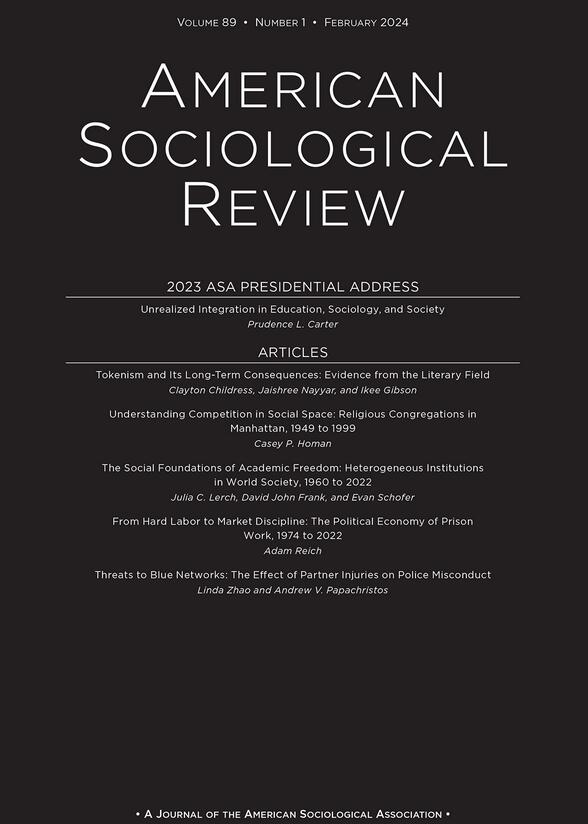“Everyone Thinks They’re Special”: How Schools Teach Children Their Social Station
IF 6.2
1区 社会学
Q1 SOCIOLOGY
引用次数: 0
Abstract
Sociologists have identified many ways that childhood inequalities promote social reproduction. These inequalities are not always explicitly linked to what children are taught about their position and direction in the world, what I term their social station. Extant case studies find that social station socialization has meritocratic underpinnings (e.g., elite boarding schoolers are taught they are the “best of the best”). But societal changes, including increased emphasis on identity in educational institutions’ and employers’ evaluative practices, raise the prospect of similar changes in childhood socialization. I conducted three years of observations in two racially diverse elementary schools—one upper-middle class, the other working class—supplemented by interviews with 101 students, teachers, and parents. Students were taught markedly different lessons about their social station, but neither school predicated this on meritocratic achievement narratives. Overall, children at the upper-middle-class school were taught to see themselves as always-already special because of their internal qualities. Children at the working-class school were taught to see themselves as conditionally good if they adhered to external rules. Variations were visible for Asian American girls at the upper-middle-class school and poor students and Black students at the working-class school. I discuss the importance of school socialization and the implications of discrimination, identity rhetoric, and individualism for social reproduction.“每个人都认为自己很特别”:学校如何教会孩子他们的社会地位
社会学家已经确定了儿童不平等促进社会再生产的许多方式。这些不平等并不总是与孩子们被教导的关于他们在世界上的地位和方向的知识,以及我所说的他们的社会地位明确联系在一起。现有的案例研究发现,社会地位社会化有精英统治的基础(例如,精英寄宿学校的学生被教导他们是“最好中的最好”)。但社会的变化,包括教育机构和雇主的评估实践中对身份的日益重视,增加了儿童社会化发生类似变化的可能性。我在两所不同种族的小学——一所是中上阶层,另一所是工人阶级——进行了三年的观察,并采访了101名学生、教师和家长。关于他们的社会地位,学生们被教授了明显不同的课程,但这两所学校都没有基于精英成就叙事。总的来说,中上阶层学校的孩子们被教导,因为他们的内在品质,他们总是认为自己已经很特别了。工人阶级学校的孩子们被教导,如果他们遵守外部规则,就会认为自己有条件地优秀。中上阶层学校的亚裔美国女孩、工人阶级学校的贫困学生和黑人学生的差异显而易见。我讨论了学校社会化的重要性,以及歧视、身份修辞和个人主义对社会再生产的影响。
本文章由计算机程序翻译,如有差异,请以英文原文为准。
求助全文
约1分钟内获得全文
求助全文
来源期刊

American Sociological Review
SOCIOLOGY-
CiteScore
13.30
自引率
3.30%
发文量
35
期刊介绍:
The American Sociological Association (ASA) is a non-profit membership association established in 1905. Its mission is to advance sociology as a scientific discipline and profession that serves the public good. ASA is comprised of approximately 12,000 members including faculty members, researchers, practitioners, and students in the field of sociology. Roughly 20% of the members work in government, business, or non-profit organizations.
One of ASA's primary endeavors is the publication and dissemination of important sociological research. To this end, they founded the American Sociological Review (ASR) in 1936. ASR is the flagship journal of the association and publishes original works that are of general interest and contribute to the advancement of sociology. The journal seeks to publish new theoretical developments, research results that enhance our understanding of fundamental social processes, and significant methodological innovations. ASR welcomes submissions from all areas of sociology, placing an emphasis on exceptional quality.
Aside from ASR, ASA also publishes 14 professional journals and magazines. Additionally, they organize an annual meeting that attracts over 6,000 participants. ASA's membership consists of scholars, professionals, and students dedicated to the study and application of sociology in various domains of society.
 求助内容:
求助内容: 应助结果提醒方式:
应助结果提醒方式:


